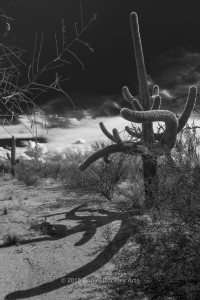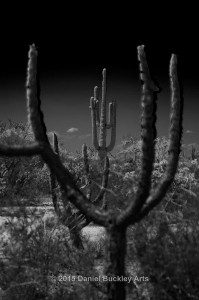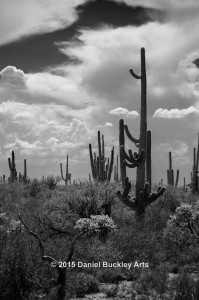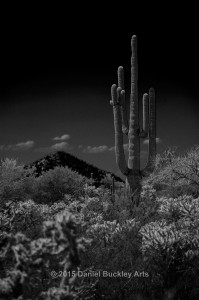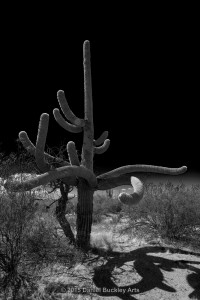Monsoon saguaros in black and white
CLICK IMAGE TO ENLARGE
For old desert rats, the summer monsoons are a religious experience, and the giant saguaro cacti are its priests.
To the Tohono O’odham (desert people) tribe, which predates the arrival of the Spanish and holds the second largest tribal reservation in the United States, the saguaros are ancestors.
 The monsoon rains of summer in the Sonoran Desert mark the beginning of the new year for the O’odham. They gather the fruit of the saguaro cacti using long poles crafted from saguaro ribs and wire. From the fruit they make jams and jellies, and a special ceremonial wine which is drunk over a period of a day or two. After that it spoils in the desert heat. It is considered a cleansing ritual and it will literally clean you out.
The monsoon rains of summer in the Sonoran Desert mark the beginning of the new year for the O’odham. They gather the fruit of the saguaro cacti using long poles crafted from saguaro ribs and wire. From the fruit they make jams and jellies, and a special ceremonial wine which is drunk over a period of a day or two. After that it spoils in the desert heat. It is considered a cleansing ritual and it will literally clean you out.The desert in the time of the monsoon is a lush experience. The Sonoran Desert is the wettest desert on earth. The heat can be epic. As the desert floor heats up, air rises, creating a low pressure area that draws moisture in. As the air rises, it cools, and if it reaches the dew point, rain may fall.
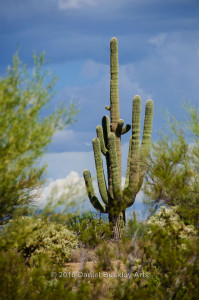 It can yield flash floods as walls of water sweep down canyons, and river beds that are more often than not dry. The associated lightning often sparks wild fires that clear the brush and make for healthier forests in the mountains around the desert floor. These fires in the mountains look like volcanos suddenly erupted.
It can yield flash floods as walls of water sweep down canyons, and river beds that are more often than not dry. The associated lightning often sparks wild fires that clear the brush and make for healthier forests in the mountains around the desert floor. These fires in the mountains look like volcanos suddenly erupted.The rains cool the desert floor, and the sweet smell of creosote fills the air. It is an experience every desert dweller comes to cherish, and the scent is synonymous to falling rain.
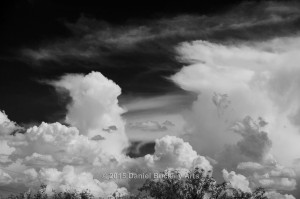 The cycle starts early in the day. Clouds build to epic towers, particularly above the ridges of the mountains. What start out as isolated islands of clouds by late afternoon have often surged together into a dark mass that blots out the sun. Fierce lightning, rain and sometimes hail erupt as isolated storms sweep across the landscape.
The cycle starts early in the day. Clouds build to epic towers, particularly above the ridges of the mountains. What start out as isolated islands of clouds by late afternoon have often surged together into a dark mass that blots out the sun. Fierce lightning, rain and sometimes hail erupt as isolated storms sweep across the landscape.This batch of photos was shot in early afternoon one monsoon day in late August along a two lane state road north of Tucson, Arizona.
This particular area is home to many very old saguaros. The older they are, the more arms they produce. The shapes and twists of these cacti seem like the work of a celestial artist.
Growing from the parched earth, arms upstretched toward the sky, they seem to beckon the summer rains.
Though originally shot in color, I have chosen to make most of these images black and white in order to create the illusion that they were shot in moonlight.
Photoshop allows me to manipulate individual colors when converting to black and white. By removing most or all of the cyan and blue I create the jet black portions of the sky.
In some shots, no clouds were included. In others they give the sense of the building torrent to come.
 By using the Photoshop sliders to add emphasis or dampen the amounts of green, yellow, red and magenta in the image during the black and white conversion I am able to lead the eye through the image and create more striking balances.
By using the Photoshop sliders to add emphasis or dampen the amounts of green, yellow, red and magenta in the image during the black and white conversion I am able to lead the eye through the image and create more striking balances.On the particular late-August day when these were shot, it was over 106 degrees, and quite steamy. Fast as I drank water, I became more dehydrated as the shoot continued. After a couple of hours I called it quits for the day and headed home.
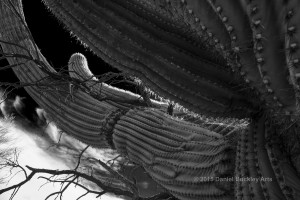 It has taken days to create these first images, and will likely take weeks and months to get them just they way I want them to be.
It has taken days to create these first images, and will likely take weeks and months to get them just they way I want them to be.These are just starting points toward what will come later.

